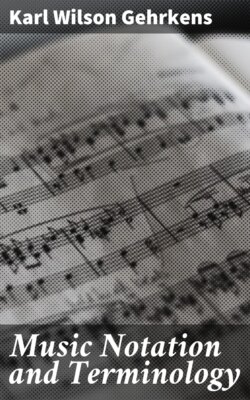Читать книгу Music Notation and Terminology - Karl Wilson Gehrkens - Страница 10
На сайте Литреса книга снята с продажи.
Оглавление1. To sharp a natural degree, use a sharp. Fig. 18.
2. To sharp a sharped degree, use a double sharp. Fig. 19.
3. To sharp a flatted degree, use a natural. Fig. 20.
4. To flat a natural degree, use a flat. Fig. 21.
5. To flat a flatted degree, use a double flat. Fig. 22.
6. To flat a sharped degree, use a natural. Fig. 23.
[Listen]
27. When two different notations represent the same pitch, the word enharmonic is applied. Thus we may say that F sharp and G flat (on keyboard instruments at least) are enharmonically the same.
This word enharmonic is used in such expressions as enharmonic change, enharmonic keys, enharmonic interval, enharmonic modulation, enharmonic relation, etc., and in all such combinations it has the same meaning, viz.—a change in notation but no change in the pitch represented.
28. A note is a character expressing relative duration, which when placed on a staff indicates that a certain tone is to be sounded for a certain relative length of time. The pitch of the tone to be sounded is shown by the position of the note on the staff, while the length of time it is to be prolonged is shown by the shape of the note. Thus e.g., a half-note on the second line of the treble staff indicates that a specific pitch (g') is to be played or sung for a period of time twice as long as would be indicated by a quarter-note in the same composition.
29. A rest is a character which indicates a rhythmic silence of a certain relative length.
30. The notes and rests in common use are as follows:
| Whole-note. An open note-head without stem. | |
| Half-note. An open note-head with stem. | |
| Quarter-note. A closed note-head with stem. | |
| Eighth-note. A closed note-head with stem and one hook. | |
| Sixteenth-note. A closed note-head with stem and two hooks. | |
| Thirty-second-note. A closed note-head with stem and three hooks. | |
| Whole-rest. | |
| Half-rest. | |
| Quarter-rest. | |
| Eighth-rest. | |
| Sixteenth-rest. | |
| Thirty-second-rest. |
31. The English names for these notes are:
Whole-note—semi-breve.
Half-note—minim.
Quarter-note—crotchet.
Eighth-note—quaver.
Sixteenth-note—semi-quaver.
Thirty-second-note—demi-semi-quaver.
The corresponding rests are referred to by the same system of nomenclature: e.g., semi-breve rest, etc.
32. Sixty-fourth and one-hundred-and-twenty-eighth-notes are occasionally found, but are not in common use. The double-whole-note (breve), made or , is still used, especially in English music, which frequently employs the half-note as the beat-unit. Thus in four-half measure the breve would be necessary to indicate a tone having four beats.
33. The whole-rest has a peculiarity of usage not common to any of the other duration symbols, viz., that it is often employed as a measure-rest, filling an entire measure of beats, no matter what the measure-signature may be. Thus, not only in four-quarter-measure, but in two-quarter, three-quarter, six-eighth, and other varieties, the whole-rest fills the entire measure, having a value sometimes greater, sometimes less than the corresponding whole-note. Because of this peculiarity of usage the whole-rest is termed Takt-pausa (measure-rest) by the Germans.
34. A bar is a vertical line across the staff, dividing it into measures. The word bar is often used synonymously with measure by orchestral conductors and others; thus, "begin at the fourteenth bar after J." This use of the word, although popular, is incorrect.
35. A double-bar consists of two vertical lines across the staff, at least one of the two being a heavy line. The double bar marks the end of a division, movement, or entire composition.
